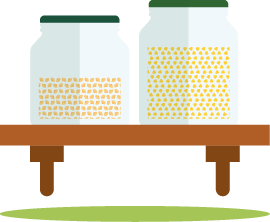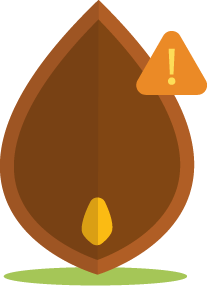
Bulgur (wheat) is a whole grain cereal with a nutty, wheat flavour. Bulgur is made from cracked and partially pre-cooked whole wheat kernels, primarily durum wheat. This process involves parboiling the wheat, drying it, and then cracking it into various sizes, from fine to coarse.
It is popular in Middle-Eastern cuisines, for quick side dishes, pilafs, or salads. It can also be served as a creamy porridge.
Bulgur pairs well with parsley, tomatoes, cinnamon, and most fresh produce.

Bulgur provides a wide array of nutrients. It is high in fibre, magnesium, phosphorus, copper, and niacin (vitamin B3). Bulgur is also a source of potassium, iron, zinc, thiamine (vitamin B1), and vitamin B6.
Bulgur contains gluten.

Toggle with the tables below to compare their nutritional content per 100 g (both cooked and uncooked) and per average portion size. You might be surprised by the differences!
| Grains | Kcal | Protein | Fat | Saturated fat | Carbohydrates | Fibre |
|---|---|---|---|---|---|---|
| Bulgur, Per 100 g, cooked | 80.00 | 3 | 0 | 0 | 14 | 4 |
| Bulgur, Per 100 g, uncooked | 340.00 | 3 | 0 | 0 | 63 | 12 |
Whole grains are all packed with carbohydrates and dietary fibre (which is a type of carbohydrate) and are naturally low in (saturated) fat. Fibre is important for our health and the prevention of many chronic diseases. That’s why the European Food Safety Authority (EFSA) recommends we eat at least 25 g of fibre per day. Sometimes, you might see whole grains labelled as ‘high in fibre’ or ‘source of fibre’ – but what does that really mean?
| Grains (% of DRV) | Calcium | Magnesium | Phosphorus | Potassium | Iron | Zinc | Copper | Vit. B1 | Vit. B2 | Vit. B3 | Vit. B6 | Folate |
|---|---|---|---|---|---|---|---|---|---|---|---|---|
| Bulgur, per 100 g, cooked | 1.25 | 8.53 | 5.71 | 3.40 | 7.14 | 5.70 | 8.00 | 5.45 | 2.14 | 6.25 | 5.93 | 5.45 |
| Bulgur, per 100 g, uncooked | 4.38 | 43.73 | 42.86 | 20.50 | 17.86 | 19.30 | 34.00 | 20.91 | 8.57 | 31.88 | 24.43 | 8.18 |
| Bulgur, per portion, cooked | 0.88 | 5.97 | 4.00 | 2.38 | 5.00 | 3.99 | 5.60 | 3.82 | 1.50 | 4.38 | 4.15 | 3.82 |
| Bulgur, per portion, uncooked | 3.06 | 30.61 | 30.00 | 14.35 | 12.50 | 13.51 | 23.80 | 14.64 | 6.00 | 22.31 | 17.10 | 5.73 |
% of DRV stands for dietary reference value. DRV stands for dietary reference value. These values estimate how much of a nutrient most healthy people in Europe need each day. Ideally, we should aim to reach 100% of these values daily. Each vitamin and mineral has their own DRV, as set by EFSA.
You might have heard that whole grains are ‘high in,’ ‘rich in,’ or ‘source of’ a certain vitamin or mineral. These term are regulated by EFSA and products must meet specific rules to be considered as such. Here’s how to interpret these contributions:

Store in an airtight container in a cool, dry place. Follow the instructions on the packaging to keep the food good for as long as possible.
Bulgur has a best-before date, meaning that it can often be eaten after that date has passed. If it looks, smell and tastes good, and the packaging is also intact, it will most likely be safe.

Follow the instructions on the packaging to cook bulgur. Cooking times can vary depending on how coarse the grain is milled.
As a general rule of thumb, use a ratio of 1 part of bulgur to 2 parts of water. Bring to boil, then simmer 10-12 minutes until tender.

Bulgur is made by cooking the entire wheat kernel, drying it and chopping it into smaller pieces. Therefore, it remains a whole grain. Cracked wheat is often used interchangeably for bulgur and is also whole grain.
Learn to identify whole grain products, cook delicious meals, find practical tips for a smooth, gradual switch, and much more!